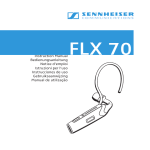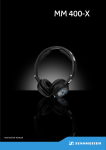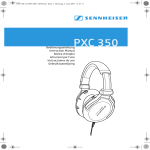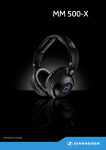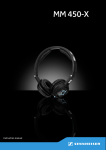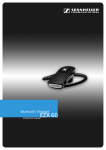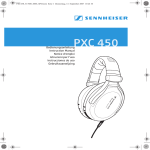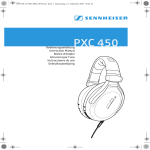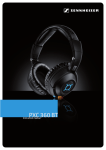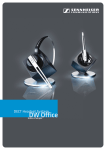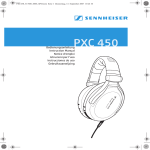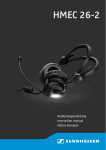Download Sennheiser MM 450-X TRAVEL Instruction manual
Transcript
Travel MM 450 Give your Phone the Sound it Deserves Instruction manual Contents Contents Important safety instructions .......................................................... 2 MM 450 ................................................................................................ 4 Delivery includes ................................................................................. 5 Product overview ................................................................................ 7 Putting the MM 450 into operation ................................................. 8 Charging the battery pack ................................................................. 8 Adjusting the headband ................................................................. 10 Switching the MM 450 on/off ........................................................ 11 Connecting the MM 450 to the audio source .............................. 12 Connecting the MM 450 using the audio cable .......................... 15 Using the MM 450 ............................................................................ 16 Adjusting the MM 450 to the listening situation ....................... 16 Changing the volume ....................................................................... 17 Remote-controlling connected devices from the MM 450 ....... 18 Resetting the settings of the MM 450 ......................................... 20 Transporting the MM 450 ................................................................ 21 Cleaning and maintaining the MM 450 ......................................... 22 If a problem occurs ... ....................................................................... 23 Accessories and spare parts ............................................................ 24 Specifications .................................................................................... 25 Manufacturer Declarations .............................................................. 26 1 Important safety instructions Important safety instructions • • • • • Please read these instructions carefully and completely before using the headset. Make these instructions easily accessible to all users at all times. Always include these instructions when passing the headset on to third parties. Only use the headset in aircraft where wireless Bluetooth® transmission is permitted. Do not use the headset in situations which require special attention (e.g. in traffic or when performing skilled jobs). Always keep the headset dry and do not expose it to extreme temperatures (normal operating temperatures: 10°C/50°F to 35°C/ 95°F). – Use the headset with care and store it in a clean, dust-free environment. – Switch off the headset after use to conserve battery power. Remove the batteries if the headset will not be used for extended periods of time. • • • • • The headset contains magnets that generate a magnetic field which could cause dangerous interference with cardiac pacemakers and implanted defibrillators. Keep the headset at least 1.2” (3 cm) from cardiac pacemakers or implanted defibrillators. Please protect your hearing from high volume levels. Sennheiser headsets also sound exceptionally good at low volumes. Only use the supplied mains unit and charging cable. To reduce the risk of fire or electric shock, do not use the device and the mains unit near water and do not expose them to rain or moisture. Unplug the mains unit from the wall socket – to completely disconnect the device from the mains – during lightning storms or – when unused for long periods of time. • • Only operate the mains unit from the type of power source specified in the chapter “Specifications” (see page 25). Ensure that the mains unit is – in a safe operating condition and easily accessible, – properly plugged into the wall socket, – only operated within the permissible temperature range, – not covered or exposed to direct sunlight for longer periods of time in order to prevent heat accumulation (see “Specifications” on page 25). • • 2 Do not operate the device and the mains unit near any heat sources. Only use attachments/accessories specified by Sennheiser. Important safety instructions Intended use Intended use of the headset includes • • having read this instruction manual, especially the chapter “Important safety instructions” on page 2, using the headset within the operating conditions and limitations described in this instruction manual. “Improper use” means using the headset other than as described in this instruction manual, or under operating conditions which differ from those described herein. Safety instructions for the Lithium-Polymer battery pack If abused or misused, the battery pack may leak. In extreme cases, it may even present • • • • a heat hazard, a fire hazard, an explosion hazard, a smoke or gas hazard. Please understand that Sennheiser does not accept liability for damage arising from abuse or misuse. Keep away from children. Do not pack charged batteries loose – danger of shorting out/fire hazard. Observe correct polarity. Do not short-circuit. Dispose of the battery pack at special collection points or return it to your specialist dealer. Switch battery pack-powered devices off after use. Only charge the battery pack with the appropriate Sennheiser chargers. When not using the battery pack for extended periods of time, charge it regularly (about every 3 months). Only charge the battery pack at ambient temperatures between 10°C/50°F and 40°C/104°F. Do not heat above 70°C/ 158°F, e.g. do not expose to sunlight or throw into a fire. Do not mutilate or dismantle. Do not continue to use a defective battery pack. Immediately remove the battery pack from an obviously defective device. When not using the device for extended periods of time, remove the battery pack from the device. Only use the original Sennheiser battery pack. Do not expose to moisture. 3 MM 450 MM 450 The MM 450 is an accessory which allows for wireless music enjoyment when used with mobile phones or other Bluetooth devices/Bluetooth compliant devices. Its supra-aural, closed design and the latest active noise compensation technology (NoiseGard) make the MM 450 especially suitable for use with in-flight entertainment systems. Due to its active and passive attenuation of ambient noise, it lets you enjoy music even in noisy environments. Bluetooth The MM 450 complies with the new Bluetooth 2.1 standard. Via its Bluetooth interface, it can be connected to a wide variety of Bluetooth enabled devices. Bluetooth wireless technology allows the MM 450 to communicate with your Bluetooth enabled device (e.g. mobile phone, MP3 player, PC or PDA) within a range of up to 10 meters. NoiseGardTM The NoiseGard active noise compensation system is based on the principle of cancelling out sound using “anti-sound” (phase-inverted sound). Tiny microphones pick up low-frequency ambient noise (up to 1 kHz) near the ear. The NoiseGard electronics use this noise to generate a sound wave which is the exact opposite (IE: at the same level but polarity reversed – 180° out-of-phase), the effect being that the polarity reversed signal cancels most of the outside noise. TalkThrough The MM 450 headset has a TalkThrough function, which allows you to communicate with other people without having to remove the headset. When TalkThrough is activated, professional quality microphones mounted on the outside of the headset pick up all acoustic signals in the immediate vicinity. Annoying background noise is electronically filtered out, only allowing the voice of the other person to pass through the headset clearly. Additional features • • • • 4 Great for travel: comfortable, rugged and foldable headset construction Optional connection via audio cable for music enjoyment without Bluetooth technology Outstanding sound quality due to patented adaptive baffle damping and Duofol diaphragms Optimum protection against ambient noise due to active and passive noise attenuation Delivery includes Delivery includes 1 MM 450 headset 1 BA 370 PX battery pack 1 USB charging cable 1 PSC 03R-050 mains unit with country adapters 1 audio cable (2.5 mm to 3.5 mm jack plug) 1 audio adapter (6.35 mm jack plug) 1 in-flight adapter (3.5 mm double mono jack plug) 1 transport case 1 quick start guide 1 CD ROM with – detailed instruction manual (PDF file) – interactive instruction manual 5 Delivery includes Overview of the pictograms Meaning of the pictograms for pressing a button Pictogram Meaning Briefly press this button. Keep this button pressed for 4 seconds. 4s Keep this button pressed until the desired setting is made or the desired action is completed. Meaning of the pictograms for the flashing of the LED Pictogram Meaning This pictogram symbolizes a flashing. This pictogram symbolizes an interruption. This pictogram symbolizes an interval. This pictogram symbolizes a continuous flashing. Examples of some of the pictograms that are used throughout this instruction manual: Pictogram Meaning The LED flashes once every 3 seconds. 3s The LED flashes 3 times per second. The LED flashes in a rhythmic sequence. The LED flashes blue 3 times and then goes off. The pictogram “i” This note provides important information! Notes marked with the pictogram “i” provide important information on the use of the headset. 6 Product overview Product overview 쐃 A Blu et oo � No � rd Ga ise th � � � 쐎 쐆 쐊 쐃 Headband 쐂 Ear pad 쐇 Microphone 쐆 Socket for charging cable 쐋 NoiseGard button 쐊 Battery pack compartment 쐏 Socket for audio cable 쐎 Microphone 쐄 Bluetooth button A Operating panel 5 6 1 4 2 3 햲 LED 햵 Rewind button 햳 Fast-forward button 햶 Master button 햴 Volume button 햷 Volume button 7 Putting the MM 450 into operation Putting the MM 450 into operation Before using the MM 450 for the first time, remove the protection strip from the battery pack. Charging the battery pack 왘 Before using the battery pack for the first time, charge it for at least 3 hours. 3h When charging the battery pack, the LED 쐅 on the battery pack lights up red. When the battery pack is fully charged, the LED 쐅 on the battery pack lights up green. 쐅 1 3s When the battery pack is almost flat, the LED 햲 on the headset flashes red. You hear a short, negative acknowledgement tone. The operating time of the battery pack depends on the device settings, the listening situation and the audio sources used. Type of use Operating time NoiseGard and Bluetooth technology 8 hours NoiseGard without Bluetooth technology 20 hours Bluetooth technology without NoiseGard 10 hours Remove the battery pack if the headset will not be used for extended periods of time. You can also charge the battery pack while using the headset. 8 Putting the MM 450 into operation Possibilities of charging the battery pack First, connect the charging cable 쐈 to the battery pack as described in section a and then connect the charging cable 쐈 to a power source as described in section b. 쐈 a b US EU AU UK a Connecting the charging cable to the battery pack You can charge the battery pack either inside or outside the headset. This is helpful if you are using a spare battery pack (to be ordered separately). To charge the battery pack inside the headset: 왘 Open the battery pack compartment cover 쐊 on the left ear cup. 쐆 왘 Connect the charging cable 쐈 to the socket for charging cable 쐆 on the headset. To charge the battery pack outside the headset: 왘 Open the battery pack compartment cover 쐊 on the left ear cup. 왘 Press the button next to the battery pack compartment and remove the battery pack. 쐊 쐈 왘 Connect the charging cable 쐈 to the socket for charging cable 쐆 on the battery pack. 9 Putting the MM 450 into operation b Connecting the charging cable to the mains unit, to a PC or to other USB devices In order to charge the battery pack, you can connect the charging cable to either the USB socket of your PC or the supplied mains unit or to other USB devices. To connect the charging cable to a PC: 쐅 왘 Connect the USB plug of the charging cable 쐈 to the USB socket of your PC. The battery pack is being charged. The LED 쐅 on the battery pack lights up red. To connect the charging cable to the mains unit: EU 왘 Connect the charging cable 쐈 to the mains unit. 왘 Plug the suitable country adapter onto the mains unit. US 왘 Plug the mains unit into a wall socket. The battery pack is being charged. The LED 쐅 on the battery pack lights up red. AU 왘 After charging, unplug the mains unit from the wall socket. UK If you have charged the battery pack outside the headset: 쐈 왘 Insert the charged battery pack into the headset’s battery pack compartment until it locks into place. 왘 Close the battery pack compartment cover 쐊. Adjusting the headband For optimum transmission quality, good noise attenuation and best possible comfort, the headband has to be adjusted to properly fit your head: 왘 Wear the headset so that the headband 쐃 runs over the top of your head. 왘 Adjust the length of the headband so that – the ear pads 쐂 rest comfortably against the ears, – you feel even, gentle pressure around your ears, – a snug fit of the headband 쐃 on the head is ensured. 왘 To ensure maximum noise attenuation, final adjustment is best made in a noisy environment. 10 Putting the MM 450 into operation Switching the MM 450 on/off CAUTION! Hearing damage due to high volumes! Listening at high volume levels for long periods can lead to permanent hearing defects. Please protect your hearing. Sennheiser headsets also sound exceptionally good at low volumes. 왘 Set the volume to a comfortable level. Switching the MM 450 on 1 5 왘 Press the Master button 햶 and keep it pressed until the flashes blue. You hear an ascending beep. LED 햲 – When switching the headset on for the first time, it will automatically go into pairing mode. The headset is waiting to be paired with a Bluetooth enabled device (see page 12). – When the headset is already paired with an audio source, the Bluetooth connection is automatically established. You hear an ascending beep and then your audio source. – When the headset is already paired with an audio source but the audio source is switched off or out of range, the LED 햲 flashes blue. The headset will try for 3 minutes to connect to one of the up to 8 previously paired audio sources. If this fails, the headset automatically switches off after 60 minutes. Switching the MM 450 off 1 5 왘 Press the Master button 햶 and keep it pressed until the flashes 3 times red. LED 햲 You hear a descending beep. The Bluetooth connection is automatically deactivated. The headset switches off. 11 Putting the MM 450 into operation Connecting the MM 450 to the audio source CAUTION! Danger of malfunction! The transmitted radio waves can impair the operation of sensitive and unprotected devices. 왘 Only use the headset in aircraft where wireless Bluetooth transmission is permitted or use the audio cable instead (see “Connecting the MM 450 using the audio cable” on page 15). The headset complies with the Bluetooth 2.1 standard. In order that data can be transmitted wirelessly using Bluetooth technology, you have to register your headset with your audio source (pairing). The headset can save the connection profiles of up to 8 Bluetooth devices with which it has been paired. After switch-on, the headset automatically connects to one of these devices. If you pair the headset with a ninth audio source, the saved connection profile of the first Bluetooth device will be overwritten. If you want to reestablish a connection with the first audio source, you have to pair the headset with this audio source again. If your audio source does not have a Bluetooth interface, use an optional dongle (see “Accessories and spare parts” on page 24). For an optimum listening experience, your audio source has to support the A2DP profile. 12 Putting the MM 450 into operation Pairing the MM 450 with an audio source 왘 Make sure that your headset is switched off (see “Switching the MM 450 off” on page 11). When switching the headset on for the first time, it will automatically go into pairing mode. The headset is waiting to be paired with a Bluetooth enabled device (see page 12). 왘 Press the Master button 햶 and keep it pressed until the alternately flashes blue and red. 1 5 LED 햲 왘 On your audio source, activate the Bluetooth function “Add a new device”. 왘 Proceed as described in the instruction manual of the audio source. 1 If a suitable audio source is found, the devices will exchange device identification information. The LED 햲 flashes 3 times blue and you hear an ascending beep. The devices have identified each other and the headset is paired with the audio source. PIN code When the audio source prompts for a password or PIN code, enter the default PIN code “0000”. If no device is found within approx. 5 minutes, the LED 햲 flashes 3 times red and you hear a descending beep. The headset will then try for 3 minutes to connect to one of the up to 8 previously paired audio sources. If this fails, the headset automatically switches off after 60 minutes. 1 왘 In this case, repeat the necessary steps to pair the headset with the audio source again. Switching the “Bluetooth connection” flashing on/off 왘 Switch the headset off (see “Switching the MM 450 off” on page 11). 1 To switch the flashing on during a Bluetooth connection: 왘 Press the Master button 햶 and keep it pressed until the alternately flashes blue and red. 5 LED 햲 왘 Briefly press the Volume button 햷. 6 To switch the flashing off during a Bluetooth connection: 왘 Briefly press the Volume button 햴. 3 Disconnecting the Bluetooth connection The Bluetooth button 쐄 is backlit, indicating the current setting. The backlighting goes off after a short time to conserve energy. 왘 Press any button on the headset to display the current setting of the Bluetooth function. 13 Putting the MM 450 into operation To disconnect the Bluetooth connection to the audio source, you can switch off the headset or the Bluetooth function. This setting is retained until the Bluetooth function is switched on again, even when you switch the headset off in the meantime. To switch the headset off: 1 5 왘 Press the Master button 햶 and keep it pressed until the LED 햲 flashes 3 times red. You hear a descending beep. The Bluetooth connection is automatically deactivated. The headset switches off. To switch the Bluetooth function off: � 14 왘 Press the Bluetooth button 쐄 and keep it pressed until the LED 햲 flashes 3 times red. You hear a descending beep. The Bluetooth button 쐄 goes off. The Bluetooth function is switched off. Putting the MM 450 into operation Connecting the MM 450 using the audio cable Connecting the audio cable You can connect the headset to the audio source using the audio cable if • • • you do not want to use the Bluetooth function, you are not allowed to use the Bluetooth function (some airlines do not allow Bluetooth transmission) or the battery pack is flat. When the audio cable is connected to the headset, the Bluetooth function cannot be switched on. 1 If the headset is already connected to the audio source via the Bluetooth interface, the Bluetooth connection is automatically disconnected when you connect the audio cable. The LED 햲 flashes 3 times red and you hear a descending beep. 왘 Connect the 2.5 mm jack plug of the audio cable to the socket 쐏 of the headset. 왘 Connect the 3.5 mm jack plug of the audio cable 쐉 to 씉 – the headphone socket of your audio source or – the audio adapter for 6.35 mm jack socket 씈 if the 3.5 mm jack plug of the audio cable is too small or 씈 – the in-flight adapter 씉 if you want to use the headset with an in-flight entertainment system. 쐉 1 When the audio cable is connected to your audio source, you hear the sound from your audio source and the LED 햲 flashes blue. Detaching the audio cable If you want to use the MM 450 as a Bluetooth headset or as a NoiseGard active noise compensation headset, you can detach the audio cable 쐉. 왘 Pull the 2.5 mm jack plug of the audio cable 쐉 from the socket 쐏 of the headset. When detaching the audio cable, the Bluetooth function is not automatically switched on. 왘 Switch the Bluetooth function on again (see “Switching the Bluetooth function on/off” on page 17). 15 Using the MM 450 Using the MM 450 Adjusting the MM 450 to the listening situation The headset has a NoiseGard function, a Bluetooth function and a TalkThrough function. Depending on the listening situation, you can switch these functions on or off. Switching the NoiseGard function on/off The NoiseGard button 쐋 is backlit, indicating the current setting. The backlighting goes off after a short while in order to conserve energy. 왘 Press any button on the headset to display the current setting of the NoiseGard active noise compensation. The NoiseGard function has to be switched on to be active. If the NoiseGard function is switched off, the MM 450 can also be used as a conventional headset. To switch the NoiseGard function on: � 2s 왘 Press the NoiseGard button 쐋 for 2 seconds. The button is backlit in red and the NoiseGard function is switched on. To switch the NoiseGard function off: 왘 Press the NoiseGard button 쐋 for 2 seconds. The red backlighting goes off and the NoiseGard function is switched off. Conserving energy Switch the NoiseGard function off after use to conserve energy. Switching the TalkThrough function on/off The MM 450 provides excellent attenuation of ambient noise. The TalkThrough function allows you to communicate undisturbed with other people without having to remove the headset even when NoiseGard is switched on. To switch the TalkThrough function on: � 왘 Briefly press the NoiseGard button 쐋. The LED 햲 lights up red. The TalkThrough function is switched on. To switch the TalkThrough function off: 왘 Briefly press the NoiseGard button 쐋. The LED 햲 goes off. The TalkThrough function is switched off. When the TalkThrough function is switched on, you cannot listen to music. 16 Using the MM 450 Switching the Bluetooth function on/off Via the Bluetooth interface, the headset can be connected to a wide variety of Bluetooth enabled devices. To switch the Bluetooth function on: � 왘 Press the Bluetooth button 쐄 and keep it pressed until the flashes 3 times blue. The Bluetooth function is switched on. LED 햲 To switch the Bluetooth function off: 왘 Press the Bluetooth button 쐄 and keep it pressed until the LED 햲 flashes 3 times red. You hear a descending beep. The Bluetooth button 쐄 goes off. The LED 햲 flashes blue and the Bluetooth function is switched off. Changing the volume The MM 450 allows you to change the volume of the audio signal: Button Duration 1s Function Button Duration Function Incrementally increases the volume Incrementally reduces the volume Continuously increases the volume Continuously reduces the volume 1s If you press the respective button briefly, the volume is changed incrementally; if you hold down the button, the volume is changed continuously. When the minimum or maximum volume is reached, you hear an acknowledgement tone. 17 Using the MM 450 Remote-controlling connected devices from the MM 450 You can directly remote-control any device supporting the AVRCP profile and connected to the MM 450 by using the buttons on the headset. Please refer to the instruction manual of your audio source for information on whether your device supports the AVRCP profile. If your device does not support the AVRCP profile, you can use an optional dongle. Using the iPod dongle or the USB dongle, you can remote-control the connected devices from the headset. Remote-controlling the audio source from the MM 450 If your headset has a Bluetooth connection to an audio source (e.g. iPod, MP3 or CD player), you can use the MM 450 to remote-control the audio source as follows: Button Duration 1s 1s Function Button Duration Function Incrementally increases the volume Incrementally reduces the volume Continuously increases the volume Continuously reduces the volume 1s Skips to the next track Skips to the previous track Fast-forwards the track Rewinds the track Plays and repeats the track 1s 1s Stops the track (acknowledgement tone) These functions are not supported by all connected Bluetooth devices. 18 Using the MM 450 Remote-controlling a mobile phone from the MM 450 1 If your headset has a Bluetooth connection to your mobile phone, the LED 햲 on the headset flashes to indicate that the mobile phone is ringing. The LED flashes 3 times blue. After a pause, the flashing is repeated. You can also hear the ring tone of your mobile phone if your mobile phone supports this function. Switching the Bluetooth function off If you press the Bluetooth button 쐄 too long, the Bluetooth function switches off! You can use the MM 450 to remote-control different functions of your mobile phone. If the mobile phones rings: Button Duration Function or Accepts the call or Rejects the call (acknowledgement tone) 2s or Ends the call If the mobile phone is switched on, does not ring and you do not make a phone call: Button Duration Function Redials the last number (acknowledgement tone) 1s Activates voice dial During a call: Button Duration Function Transfers the ongoing call back to the mobile phone 5s 2s Any button Activates the muting function (acknowledgement tone) Deactivates the muting function 19 Using the MM 450 Resetting the settings of the MM 450 You can reset all settings of your headset to the factory default settings. This allows you to prevent that other users of the headset can access your Bluetooth enabled devices. You can then pair five new devices with the headset. 왘 Press the Master button 햶 and keep it pressed until the LED 햲 flashes 3 times red. The headset switches off (see “Switching the MM 450 off” on page 11). 1 5 왘 Press the Master button 햶 and keep it pressed until the alternately flashes blue and red. 1 5 � 20 2s 5s LED 햲 왘 Press the Bluetooth button 쐄 and keep it pressed until the settings of the headset are reset. Transporting the MM 450 Transporting the MM 450 For space-saving transportation, the headset can be folded up flatly and compactly. 왘 Rotate the ear cups by 90°. 왘 Tuck the ear cups between the headband. 왘 Place the headset flat into the transport case. Your accessories can be transported in front bag of the transport case: • • Audio adapter (6.35 mm jack plug) In-flight adapter (3.5 mm double mono jack) 21 Cleaning and maintaining the MM 450 Cleaning and maintaining the MM 450 Cleaning the MM 450 CAUTION! Liquids can damage the electronics of the device! Liquids entering the housing of the device can cause a shortcircuit and damage the electronics. 왘 Keep all liquids far away from the device. 왘 Do not use any cleansing agents or solvents. For reasons of hygiene, you should clean the headset regularly: 왘 Before cleaning, make sure that the headset is not recharged via the mains. 왘 Only use a soft, slightly damp cloth to clean the headset. Replacing the ear pads You can replace the ear pads. Spare ear pads are available as accessories (see “Accessories and spare parts” on page 24). 왘 Grasp the edge of the ear pad 쐂 behind the ear cup and peel it up and away from the ear cup. 왘 Slide the new ear pad 쐂 onto the ear cup. 쐂 22 If a problem occurs ... If a problem occurs ... Problem Possible cause Solution No operation indicator – headset cannot be switched on The battery pack is flat. Recharge the battery pack (see page 8). No audio signal when the audio cable is connected The jack plug of the audio cable is not properly connected. Check the connection to your audio source (see page 15). No audio signal The headset is switched during Bluetooth off. connection The headset is not paired with an audio source. Headset cannot be paired Switch the headset on (see page 11). Check if the headset is paired. If necessary, pair the headset with the audio source again (see page 13). The Bluetooth function on the headset is switched off. Switch the Bluetooth function on the headset on (see page 17). The audio cable is connected to the headset. The connection of the audio cable automatically switches off the Bluetooth connection. Remove the audio cable and then switch the Bluetooth function on again (see page 17). The volume is adjusted too low. Increase the volume (see page 17). The pairing does not work. Check if the audio source supports the A2DP profile. If not, use one of the optional dongles. The audio source is switched off. Switch the audio source on (see page 12). No audio signal The headset is switched during NoiseGard off. operation The TalkThrough function is switched on. When in TalkThrough mode, the audio signal is not available. Switch the headset on (see page 11). Headset does not react to any button press The operation of the headset is faulty. Remove the battery pack from the headset. Reinsert the battery pack into the headset. Switch the headset on again. Bluetooth connection is suddenly interrupted The Bluetooth button has been pressed too long. Switch the Bluetooth function on (see page 17). Switch the TalkThrough function off (see page 16). 23 Accessories and spare parts Accessories and spare parts The following MM 450 accessories are available from your specialist dealer: 24 Cat. No. Accessory/spare part 531404 Ear pads, 1 pair 531405 Headband padding, 1 pair 521829 PSC 03R-050 mains unit with 4 country adapters (EU/UK/US/AU) 531406 Audio cable (2.5 mm jack plug to 3.5 mm jack plug) 525731 In-flight adapter (3.5 mm double mono jack) 531407 USB cable (microUSB to USB) 530695 BA 370 PX battery pack 502388 BTD 300 Audio 502390 BTD 300 USB 502389 BTD 300i Specifications Specifications Transducer principle dynamic, closed Ear coupling supra-aural Frequency response 15–22,000 Hz Nominal impedance active/passive 590/100 Ω Sound pressure level at 1 kHz and 1 Volt 107 dB SPL THD at 1 kHz < 0.1% Audio connection 3.5 mm stereo jack socket Audio adapter 6.35 mm stereo jack plug In-flight adapter 3.5 mm double mono jack plug Cable length Audio cable Charging cable 1.4 m 0.8 m Weight 105 g BA 370 PX battery pack Charging time Operating time 3.7 V; 250 mAh Lithium-Polymer 3 hrs 8 hrs/10 hrs/20 hrs Operating temperature range 0°C to +40°C Storage temperature range –10°C to +70°C Passive noise attenuation 25 dB NoiseGard active noise compensation 23 dB PSC 03R-050 mains unit Nominal input voltage 110–240 V~ Nominal input current max. 0.2 A Mains frequency 50–60 Hz Nominal output voltage 5V Nominal output current max. 0.5 A Operating temperature range 0°C to +45°C Storage temperature range −40°C to +85°C Relative humidity 20 to 90% Weight approx. 61 g Bluetooth Bluetooth® version 2.1 + EDR Range up to 10 m Transmission frequency 2.4 GHz Transmission power 8 dBm Protocoles A2DP, AVRCP Codecs SBC 25 Manufacturer Declarations Manufacturer Declarations Warranty Sennheiser Communications A/S gives a warranty of 24 months on this product. For the current warranty conditions, please visit our website at www.sennheiser.com or contact your Sennheiser partner. CE Declaration of Conformity These devices comply with the basic requirements and other relevant provisions of the following directives: • • • • • • R&TTE Directive (1999/5/EC) EMC Directive (2004/108/EC) Low Voltage Directive (2006/95/EC) RoHS Directive (2002/95/EC) WEEE Directive (2002/96/EC) Battery Directive (2006/66/EC) The declaration is available on the internet at www.sennheiser.com. Before putting the devices into operation, please observe the respective countryspecific regulations! Statements regarding FCC and Industry Canada FCC Declaration of Conformity (DoC) SENNHEISER Model No: MM 450 We, Sennheiser Electronic Corporation Strat. Marketing • Stefanie Reichert One Enterprise Drive • Old Lyme • CT 06371 • USA Tel: +1 (860) 434 9190, ext. 144 Fax: +1 (860) 434 1759 declare the above device comply with the requirements of Federal Communications Commission. This device complies with Part 15 of the FCC rules. Operation is subjected to the following two conditions: 1) This device may not cause harmful interference, and 2) This device must accept any interference received, including interference that may cause undesired operation. Responsible Party: John Falcone This device complies with Part 15 of the FCC Rules and with RSS-210 of Industry Canada. Operation is subject to the following two conditions: (1) this device may not cause harmful interference, and (2) this device must accept any interference received, including interference that may cause undesired operation. 26 Manufacturer Declarations This equipment has been tested and found to comply with the limits for a Class B digital device, pursuant to Part 15 of the FCC Rules. These limits are designed to provide reasonable protection against harmful interference in a residential installation. This equipment generates, uses and can radiate radio frequency energy and, if not installed and used in accordance with the instructions, may cause harmful interference to radio communications. However, there is no guarantee that interference will not occur in a particular installation. If this equipment does cause harmful interference to radio or television reception, which can be determined by turning the equipment off and on, the user is encouraged to try to correct the interference by one or more of the following measures: • • • • Reorient or relocate the receiving antenna. Increase the separation between the equipment and receiver. Connect the equipment into an outlet on a circuit different from that to which the receiver is connected. Consult the dealer or an experienced radio/TV technician for help. This class B digital apparatus complies with the Canadian ICES-003. Changes or modifications made to this equipment not expressly approved by Sennheiser electronic Corp. may void the FCC authorization to operate this equipment. In compliance with: USA FCC ID: DMOCBSSAB Since the radiated output power of this Class1 BT device is far below the FCC radio frequency exposure limits, it is not subjected to routine RF exposure evaluation as per Section 2.1093 of the FCC rules. Canada IC: 2009D – MMBTX Europe Australia / New Zeeland Singapore China CMIIT ID: 2009DJ3544 Taiwan CCAB09LP4090T9 Japan R 203WWJN000007 Russia ME61 Korea SC9 - MM450 27 Manufacturer Declarations Trademarks Sennheiser and NoiseGardTM are registered trademarks of Sennheiser electronic GmbH & Co. KG. The Bluetooth® word mark and logos are registered trademarks owned by Bluetooth SIG, Inc. and any use of such marks by Sennheiser electronics GmbH & Co. KG is under license. iPod® and iPhone® are registered trademarks of Apple Computer, Inc. 28 Sennheiser Communications A/S 6 Langager 2680 Solrød Strand Denmark Phone: +45 5618 0000 Fax: +45 5618 0099 www.sennheisercommunications.com Publ. 01/09 532818/A02































